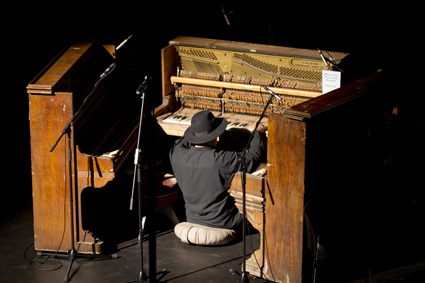 |
Ross Bolleter, Daughters of Time, Piano Tapestry, THNMF 2011 photo © Brad Serls |
The opening piece of the night, and the one furthest removed from the romantic tradition, was by Ross Bolleter improvising on what he calls “Daughters of Time.” These are three pianos taken from various locations in outback Australia where, through years in the harsh climate, they have been weathered to the point of ruin. The instruments are heavy with memory. They have spent lifetimes in outback hotels and on verandas at the mercy of the elements. The symbolism is stark but affecting. It is impossible to distance the sound of these pianos from their connotations. The unevenly resonating strings and muted chimes instantly conjure images of the Australian outback and of an uneasy relationship to European heritage.
The visual element of the performance furthers such associations. Bolleter sits not on a piano stool but on a cushion on the floor, his head down and arms outstretched in order to reach the three pianos surrounding him. It’s a far remove from the exaggerated raptures of Liszt or Chopin but Boletter’s performance is nonetheless intense and introspective. Improvised freely, the music exists in two time frames; firstly in the immanent present of the improvisation, and secondly in the imagined memory of these Daughters of Time. As Ross Bolleter writes “Ruins are what remain–still passing away to be sure, but lingering.”
The romantic image of the piano is also closely associated with those other romantic inventions, the solo recital and the instrumental virtuoso. This is a world that second performer, Mark Gasser, inhabits. To see a performer so totally in control of his instrument is mesmerising. In Gasser’s first two pieces by Ronald Stevenson, there is an incredible athleticism to the performance. The music is loud, complex and unrelentingly fast.
Gasser’s third piece, Luigi Nono’s ...sofferte onde serene... (...serene waves endured...) uses a recorded performance of Nono’s friend, the pianist Maurizio Pollini as its seed. This recording, made slightly before Pollini’s death, blends with similar material played by Gasser. Nono says that the recorded piano resonates like the bells in the lagoon near his house and the serene bells of a funeral. The result is of still, calm beauty in the face of tragedy.
The last piece, by Australian composer Lindsay Vickery, employs the Yamaha Disklavier, which uses data from a laptop to drive small motors attached to the piano’s hammers. This automated material blends with passages played by Gasser–a duet for man and machine. Having keys move of their own accord thwarts associations with the piano as an extension of the performer’s fingers. Coming straight after Nono’s piece, there is a supernatural element to the performance, as if ghosts live in the keyboard.
The final performance of the night was from Anthony Pateras. Classically trained, he spent years experimenting with prepared pianos—using nails, coins and other objects inserted between the strings to expand the timbral and gestural capabilities of the instrument. Tonight’s piano is not tampered with but under Pateras’ fingers gesture is still the dominant force. The notes are so densely overlaid that any sense of pitch (other than in the most general sense of high or low) is meaningless. The music pivots between swarms of clustered notes and hammering percussive tones.
This performance too was improvised but with a stronger sense of form than Boletter’s. Pateras’ personality features prominently in his performances and he had clearly made a conscious effort not to engage the audience in any direct manner. He walked onto the stage in sandals (which he removed to play) and sat motionless at the piano for almost a minute before commencing, willing himself into a musical trance. This aesthetic is a big part of the way that Pateras brands himself. It seems to be a reaction against the ego and conservatism of the solo recital and, simultaneously, a bid for the audience’s undivided attention. This contradiction only serves to heighten the appeal of his music and of Pateras himself as an indispensable part of it. This is music that only he can play.
The aim of Piano Tapestry was to present three different approaches to the piano. Bolleter’s symbolism, Gasser’s virtuosity and electronics and Pateras’ gestures formed a triptych of contemporary approaches to the instrument—modern tastes, techniques and technologies meeting with the ghosts of the piano’s history.
Totally Huge New Music Festival 2011: Piano Tapestry, Mark Gasser, Ross Bolleter, Anthony Pateras, presented by Tura New Music, Perth State Theatre Centre, Studio Underground, presented by Tura New Music, Sept 16; http://www.tura.com.au/totally-huge-music-festival/2011/about
Henry Andersen, a composer and performer of new music, living in Perth, is currently studying toward a Bachelor of Music Technology and Composition at the Western Australian Academy of Performing Arts. His interest in music traverses a wide range of styles and he has been involved in music for live performance, sound installation, dance, film and other mixed media.
RealTime issue #106 Dec-Jan 2011 pg. 38
© Henry Andersen; for permission to reproduce apply to [email protected]








 back
back